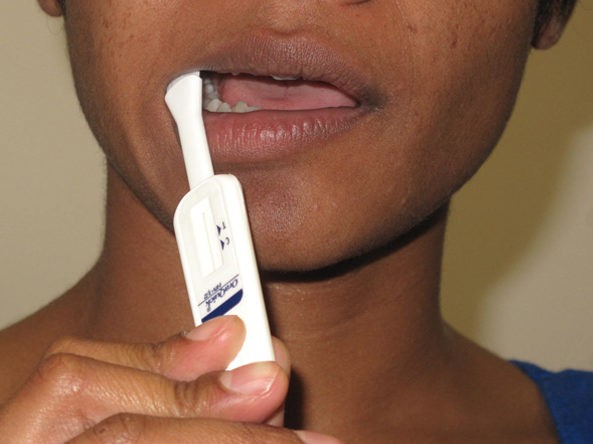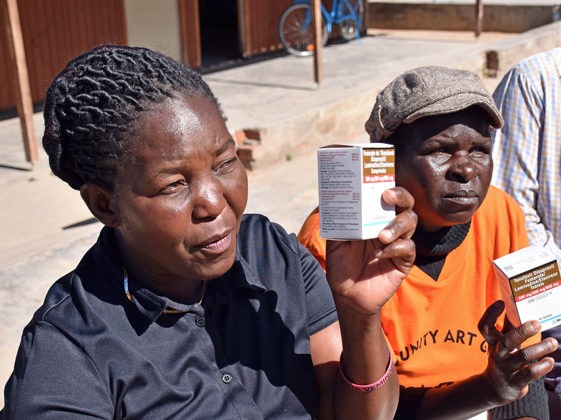Article and Study Summary
Direct provision versus facility collection of HIV self-tests among female sex workers in Uganda: A cluster-randomized controlled health systems trial.
Published in:
PLoS Med. 2017;14(11): e1002458. https://doi.org/10.1371/journal.pmed.1002458
Authors:
Ortblad K, Kibuuka Musoke D, Ngabirano T, et al.
Summary:
This article reports on the results of a three-arm cluster-randomized controlled trial that was conducted among female sex workers (FSW) to assess the effect of two HIV self-test distribution models on HIV testing and linkage to care outcomes. FSW in Kampala, Uganda were recruited by peer educators and groups of eight were randomized to receive HIV self-tests directly, a coupon that could be redeemed at a private health facility for a self-test, or the standard of care. After four months of follow-up, the study found that the direct provision of HIV self-tests by peer educators increased recent HIV testing compared to distribution at a facility or the standard of care. Access to self-testing also increased the frequency of repeat HIV testing and decreased the amount of HIV testing done at health facilities in this population. There was a high level of uptake of self-tests, and adverse events related to self-testing were rare. However, among those who tested positive for HIV, there was some evidence of poorer linkage to care in the self-testing intervention groups compared to the standard of care. This study supports using an active distribution model for HIV self-tests, over a passive model such as facility collection points for FSW. It also highlights the need to strengthen procedures for linkage to care following a positive self-test result.
Download full synopsis here or read below.
Discussion Questions:
- How could the results presented in this article inform testing strategies in the populations that you work with?
- What programmatic challenges do you foresee as the use of HIV self-testing becomes more widespread? Do you have any best practices to share?
Please share your thoughts and experiences with us in the comments section below.
Full Synopsis:
Study Summary
This three-arm cluster-randomized controlled trial was conducted among female sex workers (FSW) in Uganda to measure the effect of direct provision of HIV self-tests, the collection of HIV self-tests at a facility, and the standard of care on HIV testing and linkage behavior after four months of follow-up.
Study Setting
- Community settings and 10 private healthcare facilities in Kampala, Uganda.
Methods
- Participants were eligible for enrollment if they: 1) were 18 years or older; 2) exchanged vaginal, anal, or oral sex for money, goods, or other items of value; 3) had never tested for HIV or self-reported a negative HIV status and no HIV test in the past three months; 4) had worked as a FSW in Kampala for at least one month and planned on continuing to work for the next four months; and 5) had never used an oral HIV self-test.
- FSW were recruited for the study by peer educators and were organized into groups of eight FSW and one peer educator.
- Peer educators completed a two-day training on how to instruct participants to use the oral HIV self-test and interpret the results, and on how to encourage linkage to HIVservices.
- Groups were randomized (1:1:1) to one of three intervention arms: 1) direct provision of HIV self-test kits; 2) coupons for collection of free HIV self-test kits in a healthcare facility; or 3) standard of care for HIV testing.
- Each group had an initial meeting during which peer educators distributed condoms, and in the intervention arms, trained participants in HIV self-testing. In the direct provision arm, participants were given an oral fluid rapid HIV self-test, and in the facility collection arm, participants were given a coupon for a free HIV self-test that could be redeemed at one of 10 private healthcare facilities.
- All participants were given a card with a toll-free hotline number to call for referral to standard HIV testing and treatment services, report adverse events, and ask questions related to HIV self-testing (intervention groups only).
- Peer educators subsequently performed individual follow-up visits for each participant at two weeks, 1.5 months and three months, in which they distributed condoms, referred participants to standard HIV testing services, and screened for adverse events. During the three month visit, a second self-test or coupon was given to participants in the direct provision and facility collection groups, respectively.
- Research assistant-administered questionnaires were conducted at baseline, one, and four months to assess sexual behavior, HIV testing experience and intimate partner violence. Follow-up questionnaires also ascertained HIV self-testing and linkage to care information.
- The primary outcome was any HIV testing, measured at one month and four months after the first group visit. This included any HIV testing that was done after the second self-test or coupon was distributed at the three-month visit.
- The secondary outcomes were HIV self-test use, seeking HIV-related medical care, antiretroviral (ART) initiation, adverse events, testing twice for HIV, and use of facility-based HIV testing services.
- All analyses were by intention to treat, and risk ratios (RR) were calculated with adjustment for clustering by peer educator group.
Study Population and Follow-up
- From October to November 2016, 1,587 potential participants were screened. Of these, 960 were enrolled and randomized, with 296 in the direct provision arm (37 groups), 336 in the facility collection arm (42 groups), and 328 in the standard of care arm (41 groups).
- Participant retention at one and four months was 96.4% and 89.7%, respectively, with no difference in loss to follow-up across study arms.
- Median age was 28 years (interquartile range [IQR] 24-32) and median years in sex work was 5 (IQR 3-8); the majority were literate (85.7%) and owned a mobile phone (94.8%).
Primary HIV Testing Outcome
- Participants in the direct provision arm were significantly more likely to test for HIVcompared to those in the standard of care arm, both at one month (95.2% vs. 71.5%, RR 1.33, 95% confidence interval [CI] 1.17-1.51) and four months (99.6% vs. 87.1%, RR 1.14, 95% CI 1.07-1.22).
- Participants in the direct provision arm were also significantly more likely to test for HIV compared to those in the facility collection arm, both at one month (95.2% vs. 80.4%, RR 1.18, 95% CI 1.07-1.31) and at four months (99.6% vs. 97.0%, RR 1.03, 95% CI 1.01-1.05).
- There was no significant difference in HIV testing between participants in the facility collection arm compared to the standard of care arm at one month (RR 1.12, 95% CI 0.96-1.32). However, by four months participants in the facility collection arm were more likely to test than those in the standard of care arm (RR 1.11, 95% CI 1.04-1.19).
Self-test Use and Secondary HIV Testing Outcomes
- The majority of participants in the facility collection arm reported using at least one coupon to collect an HIV self-test, with only 4.7% reporting that they did not use any of their coupons.
- In the direct provision arm, 94.1% reported using a self-test at one month and 98.5% by four months. In the facility collection arm, 77.9% and 93.9% used at least one self-test by one and four months, respectively.
- At four months, repeat HIV testing was reported by 87.0% of participants in the direct provision arm, 71.4% in the facility collection arm, and 57.6% in the standard of care arm (p<0.001).
- Facility-based testing was significantly lower among participants in the direct provision arm and facility collection arm compared to the standard of care arm, both at one month (9.3% and 8.7%, respectively, vs. 66.8%) and at four months (21.4% and 25.3%, respectively, vs. 85.8%).
- After 4 months, 16.9% (n=44) of participants in the direct provision arm, 27.7% (n=80) in the facility collection arm and 18.0% (n=53) in the standard of care arm reported testing positive for HIV.
Linkage to Care Outcomes
- Compared to the standard of care arm, fewer participants had sought medical care for HIV at one month in the direct provision arm (5.9% vs. 8.3%, RR 0.65, 95% CI 0.30-1.41) and the facility collection arm (4.2% vs. 8.3%, RR 0.50, 95% CI 0.24-1.04). These differences were not statistically significant and were reduced in magnitude at four months, with 10.4% seeking care in the direct provision arm, 12.8% in the facility collection arm and 12.6% in the standard of care arm.
- Among participants who reported testing positive for HIV, linkage was lower in the HIV self-testing intervention arms, compared to the standard of care arm, and the difference in the facility collection arm was statistically significant, both at one month (RR 0.38, 95% CI 0.21-0.67) and four months (RR 0.66, 95% CI 0.47-0.94).
- There were no statistically significant differences in ART initiation across study arms.
Adverse Events Outcomes
- Four adverse events were reported, of which two were related to HIV self-testing: an interpersonal violence event and mental distress following a false positive HIV self-test result.
- Only 7% of participants called the toll-free hotline after four months and only 14% (n=8) of these calls were for reasons related to HIV self-testing.
Critical Analysis
This study demonstrated that the direct provision of HIV self-tests to FSW increased HIVtesting compared to facility-based HIV self-test distribution or the standard of care. There was also evidence that self-testing increased the frequency of HIV testing in this high-risk population, and decreased the amount of HIV testing done at health facilities. While adverse events related to self-testing were rare, there was some evidence of poorer linkage to HIV care in the self-testing intervention groups compared to the standard of care.
The following points should be considered when interpreting the study findings:
- In this study, FSW were taught how to use HIV self-tests by trusted peers in small, structured groups, which could be challenging to replicate in high-volume settings.
- Private healthcare facilities were used to distribute self-tests in the facility collection arm, and facility staff had been sensitized to reduce stigma and discrimination against FSW. This environment likely contributed to the high proportion of FSW who redeemed their coupons for HIV self-tests.
- Only 5.9% of participants reported no previous HIV test, which means the vast majority would have previously undergone standard pre- and post-test counseling.
- Participants were selected by peer educators from within their social networks, which may have resulted in selection bias.
- Ethical considerations around informed consent meant that FSW under the influence of substances were not enrolled in the trial, which may limit the generalizability of study findings.
- The majority of participants were literate and had access to mobile phones, which may further limit external validity.
- The short follow-up period of four months would not have captured self-test use or linkage to care that was delayed beyond this period.
- All outcomes were self-reported and participants were paid for completing the study assessments, which may have introduced social desirability bias.
- The study was not powered to detect differences in linkage among those who tested HIV positive, and this analysis may be subject to selection bias.
Implications
This large cluster-randomized trial demonstrated that the direct provision of HIV self-tests increased recent and repeat HIV testing in urban FSW, compared to providing a coupon for self-test collection at a facility and the standard of care. There was a high level of uptake and acceptance of self-testing in this population, but also some evidence of poorer linkage to care after a positive self-test compared to facility-based testing. As countries design HIVself-testing programs for key populations, they should consider using an active model of direct provision of self-test kits over a passive model, such as facility collection points. All models of self-test distribution should be coupled with interventions to strengthen linkage following a positive test result, especially as countries strive for rapid initiation of ART.









